
Hello Everyone
Over the past few days, my family and I visited Wat Arun Thammasathan, which is enshrined within the Phra Mahathat Ratchamongkol Chedi Sirichaiphum, also known as Phra That Chaiyaphum.
This temple is located in Phu Lanka, Kaeng Khro District, Chaiyaphum, a province in northeastern Thailand 🇹🇭. Perched atop a hill, it’s quite a journey from the city, requiring a scenic drive through several hills shaded by lush trees. But I assure you, the visit is absolutely worth it! The temple’s beauty stands out on the hilltop, featuring a blend of Lanna architecture and the Lan Xang art style.
Let’s go!
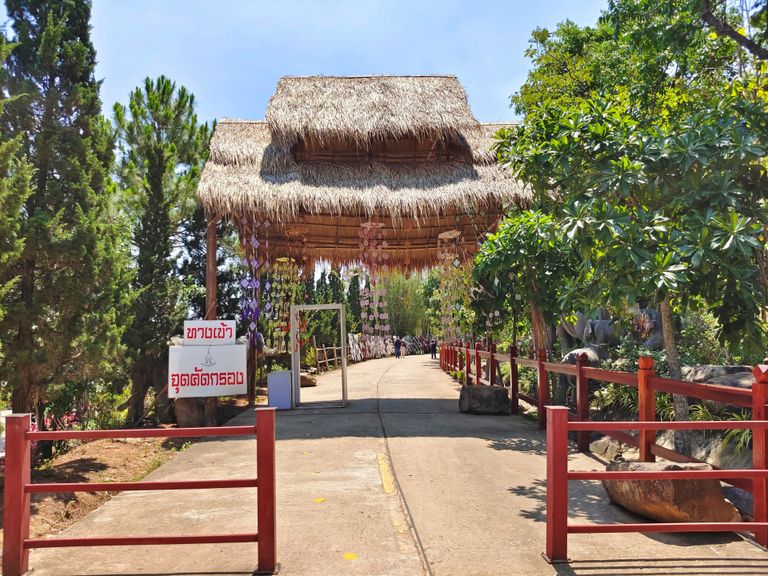
At the entrance, there is a dispenser spraying alcohol for disinfection. Since it was quite hot that day, I recommend bringing an umbrella and wearing socks. Keep in mind that shoes must be removed within the relic area, and the tile floors can become extremely hot under the sun.
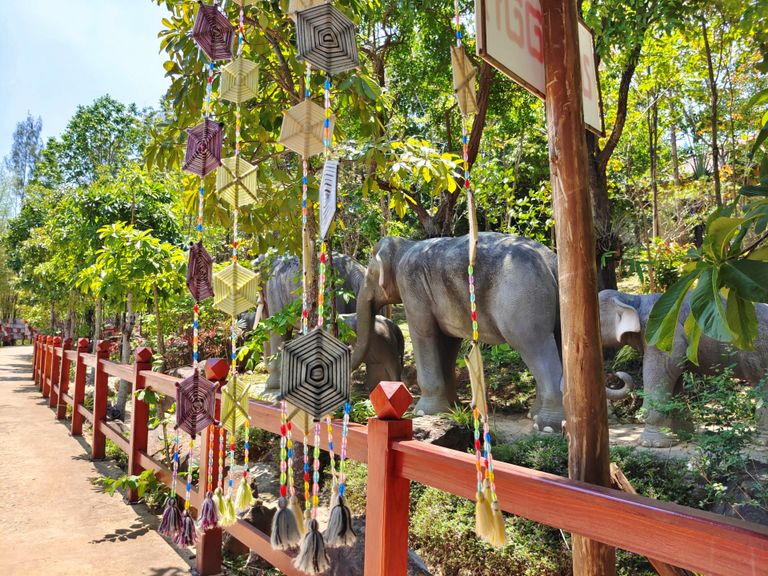
เมื่อช่วง 2-3 วันที่ผ่านมาบัวและครอบครัวได้เดินทางไปเที่ยวที่วัดอรุณธรรมสถาน ซึ่งเป็นที่ประดิษฐาน พระมหาธาตุรัชมงคลเจดีย์สิริชัยภูมิ หรือพระธาตุชัยภูมิ ตั้งอยู่บนภูแลนคา อำเภอแก้งคร้อ จังหวัดชัยภูมิ ซึ่งเป็นจังหวัดหนึ่งทางภาคอีสานของประเทศไทย วัดแห่งนี้ห่างไกลจากตัวเมืองพอสมควร เพราะวัดแห่งนี้ถูกสร้างอยู่บนเนินเขา จึงเป็นการขับรถขึ้นเขาหลายลูก ตลอดเส้นทางร่มรื่นไปด้วยต้นไม้แต่รับรองว่าคุ้มค่าที่ได้ไปเยี่ยมชมแน่นอนค่ะ วัดแห่งนี้มีความงดงามและโดดเด่นอยู่บนยอดเขาด้วยสถาปัตยกรรมศิลปะล้านนาผสมผสานกับศิลปะแบบล้านช้าง เราไปชมกันเล้ยยยยย..... บริเวณทางเข้าจะเป็นตู้พ่นแอลกอฮอล์เพื่อฆ่าเชื้อโควิด วันนั้นอากาศร้อนพอสมควรแนะนำให้นำร่มไปด้วย และควรสมถุงเท้าเพราะภายในบริเวณพระธาตุต้องถอดรองเท้า พื้นกระเบื้องเมื่อโดนแดดจะร้อนมากๆ
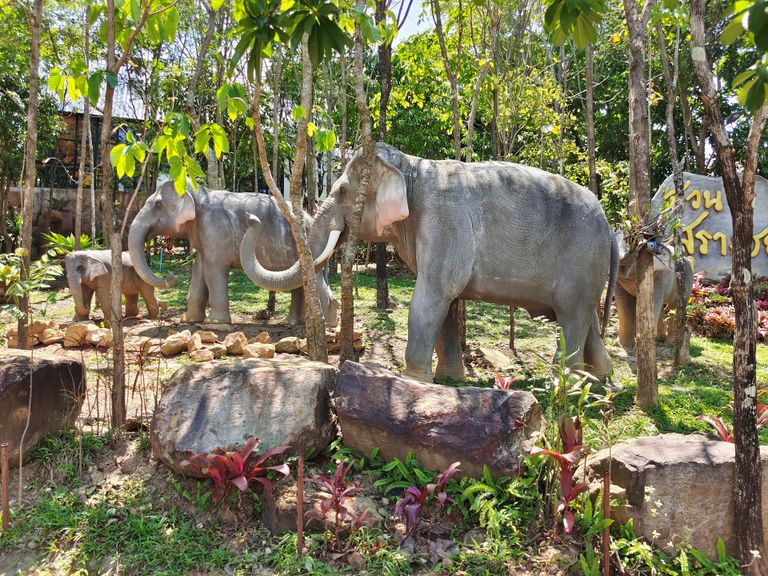
Along the way up to the relics, there are several realistic elephant statues.
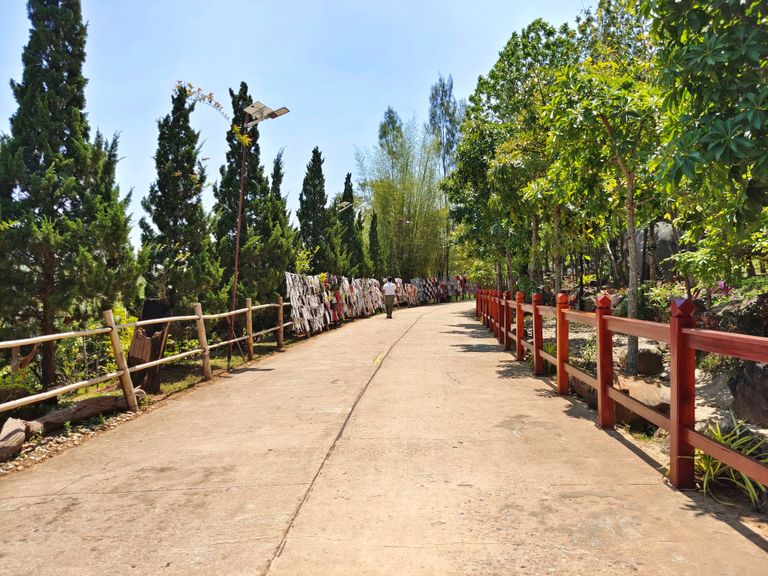
ระหว่างทางเดินขึ้นไปยังพระธาตุจะมีโคลงช้างซึ่งเป็นรูปปั้นเหมือนช้างจริงๆ อยู่หลายเชือก และมีการตกแต่งรั้วด้วยผ้าชิ้นเล็กๆ มากมายอย่างสวยงาม
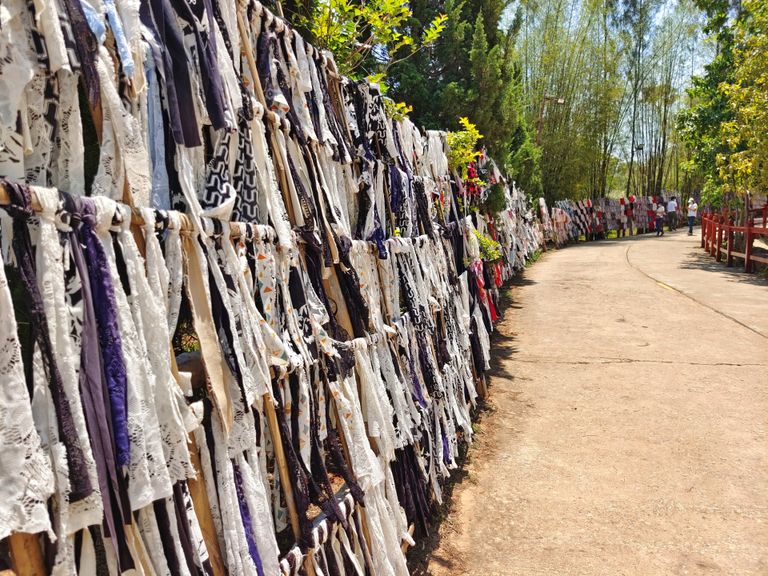
The walkway is lined with a fence adorned with small pieces of cloth in various beautiful colors.
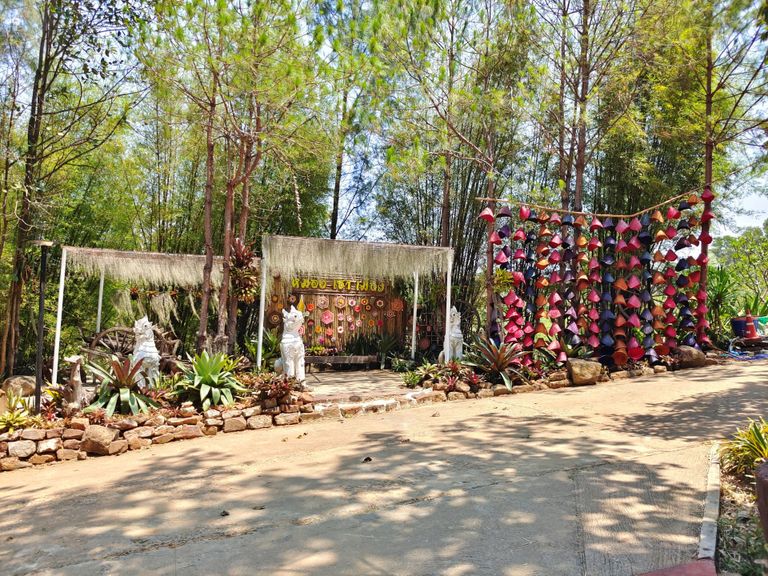
Along the path, locals have used traditional materials to decorate various spots, enhancing the beauty of the area and creating picturesque photo opportunities.
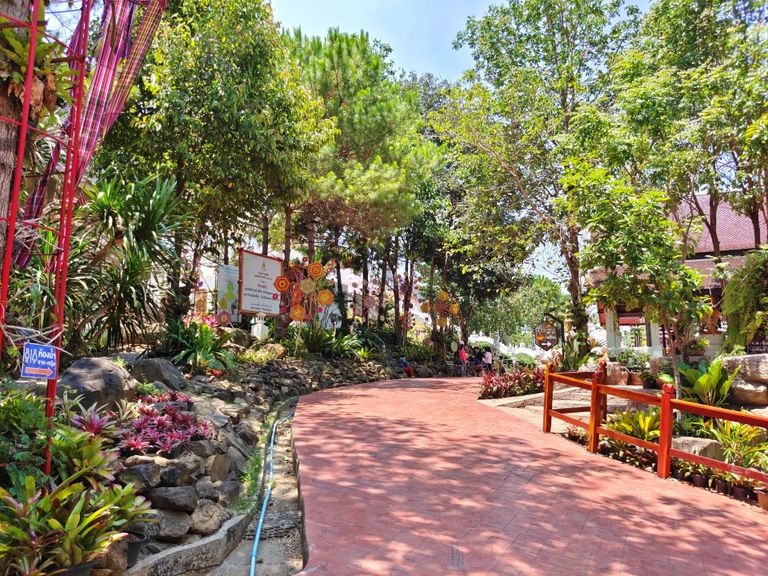
ตลอดเส้นทางที่นักท่องเที่ยวเดินผ่านจะมีการนำวัสดุสิ่งของที่มีอยู่ในท้องถิ่นนำมาตกแต่งตามสถานที่ต่างๆ เพิ่มความสวยงามและเป็นจุดถ่ายรูปที่สวยมากๆ

Upon reaching this area, you must remove your shoes. To the right, there is a small pavilion, and in front stands a giant statue holding a mace, flanked on both sides.

In Buddhism, giants, or yakshas (ยักษ์ in Thai), are believed to act as protectors of sacred sites. Their presence symbolizes the defense against evil forces and negative energies that threaten to harm Buddhism or disrupt spiritual harmony. Often depicted with fierce expressions and wielding weapons like maces, these guardian figures are strategically placed at temple entrances, gates, or near important relics to ward off malicious spirits and ensure peace within the temple grounds.
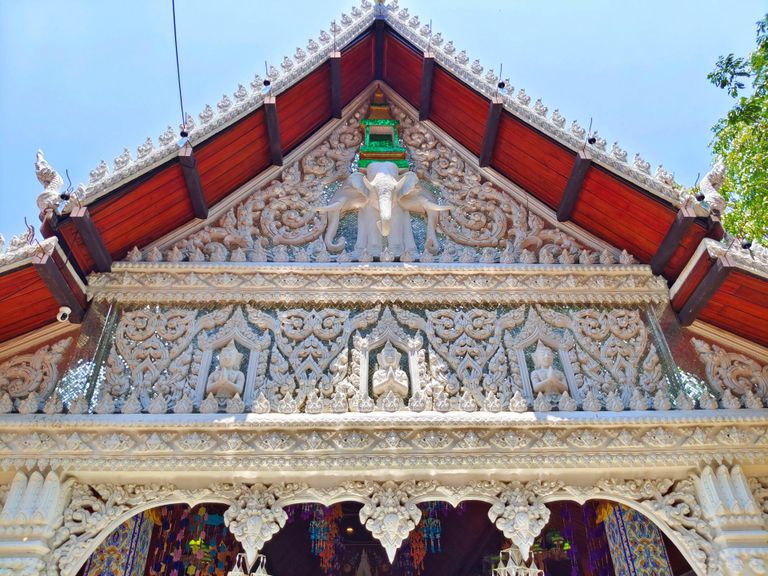
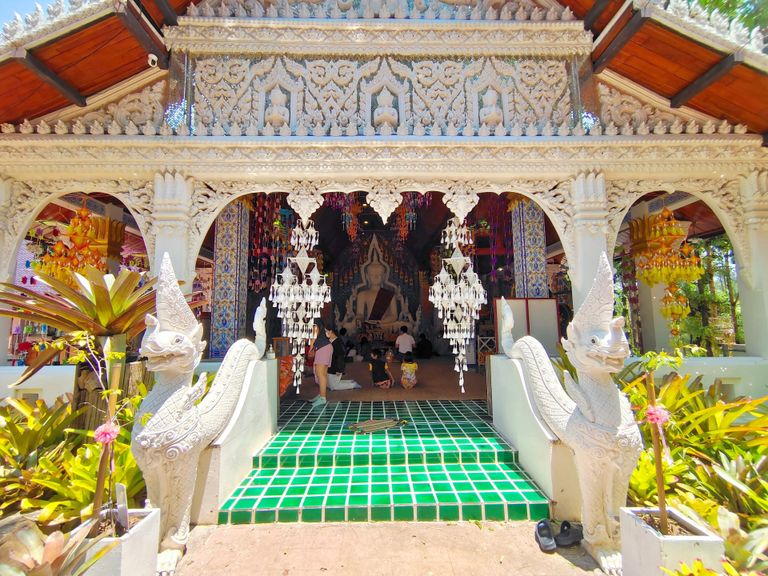
Inside this small pavilion stands a large white Buddha image, radiating serenity and peace. Visitors and Buddhists are welcome to make merit by participating in rituals such as lighting incense, offering flowers, or donating alms. These acts of merit-making are believed to accumulate good karma and spiritual blessings. Additionally, offerings can be made to monks, who serve as spiritual guides, further strengthening the connection between laypeople and the Buddhist teachings.
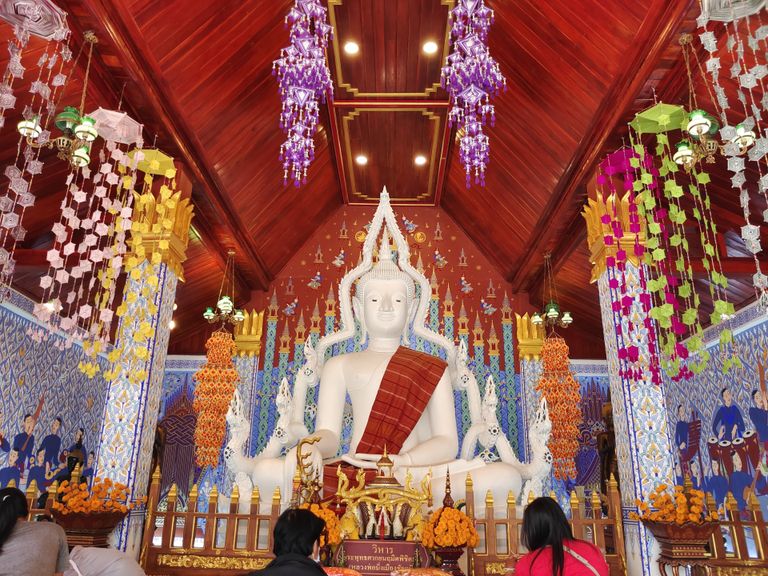
ภายในศาลาหลังเล็กนี้ เป็นที่ประดิษฐานพระพุทธรูปสีขาวองค์ใหญ่ และพุทธศาสนิกชนสามารถเข้าไปทำบุญถวายสังฆทานกับพระสงค์ได้
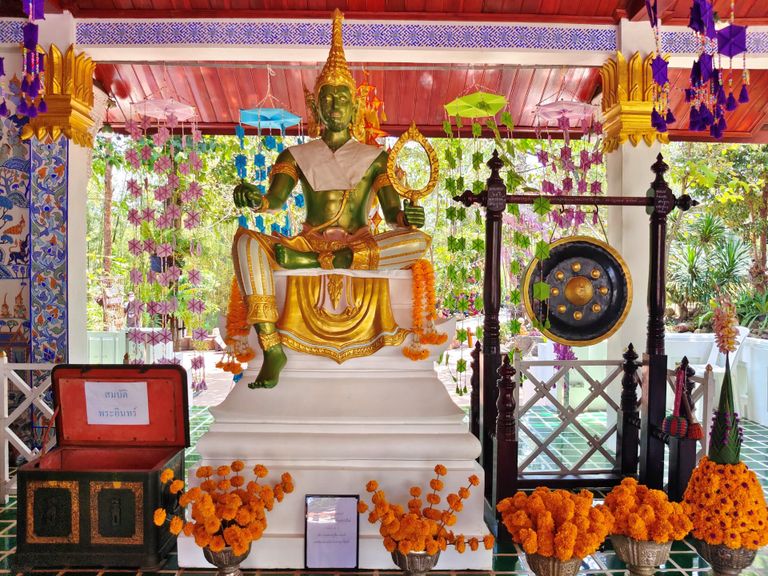

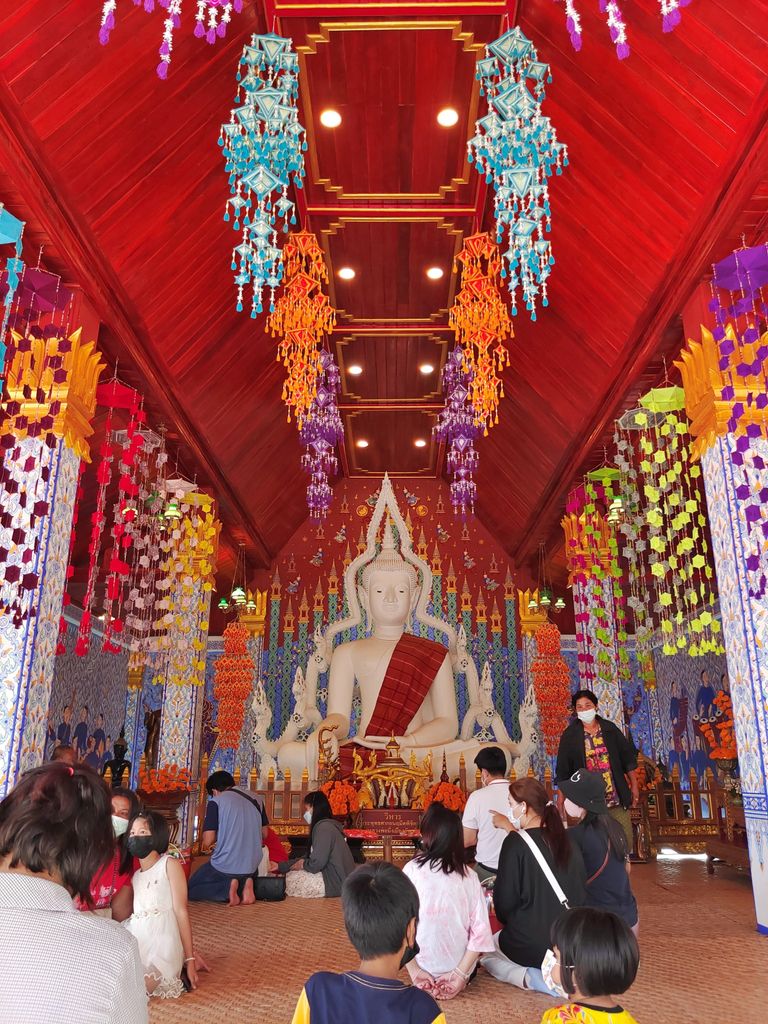
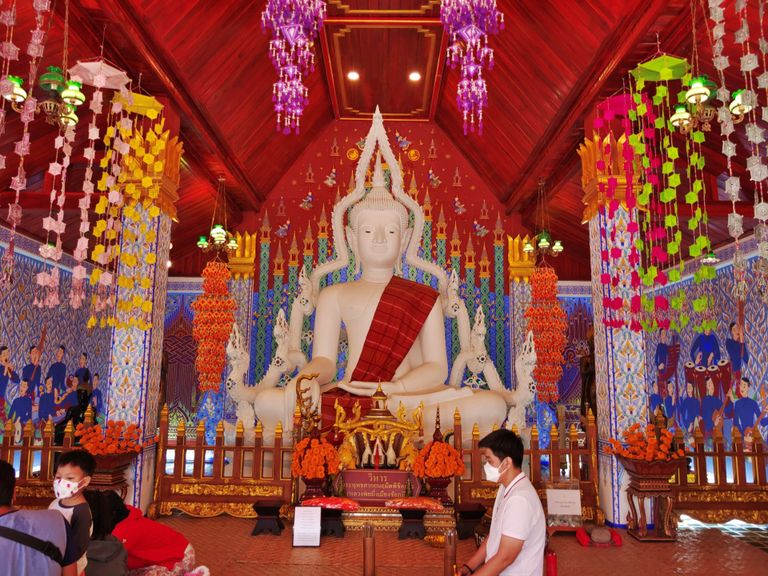
Every day, many tourists and Buddhists visit to make merit. The pavilion is beautifully decorated, showcasing the handicrafts of people with deep faith in Buddhism. Inside, colorful hanging mobiles add vibrancy to the space. At the center stands a large white Buddha image, serving as the focal point. The walls are adorned in white and blue, depicting stories of angels in heaven, adding to the pavilion's serene and spiritual atmosphere.
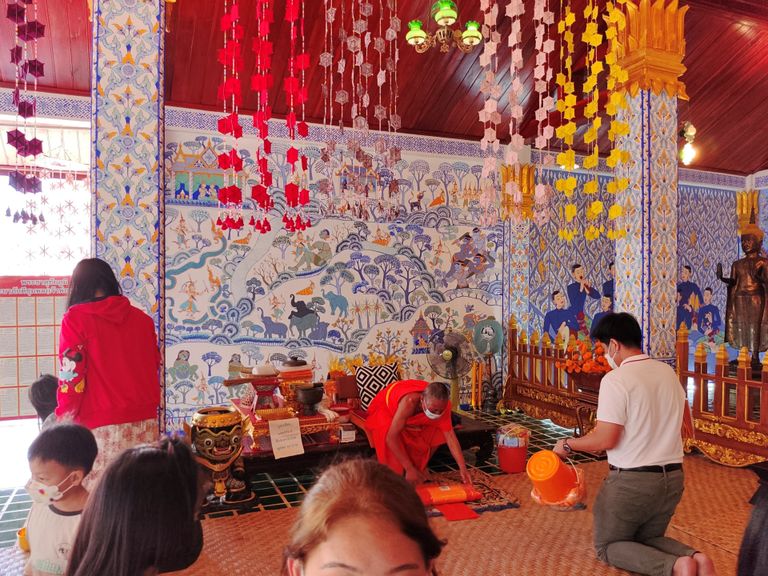
ในแต่ละวันมีนักท่องเที่ยวและพุทธศาสนิกชน เดินทางมาเที่ยวและทำบุญเป็นจำนวนมาก ภายในศาลาแห่งนี้ตกแต่งได้อย่างสวยงาม เป็นงานฝีมือของผู้มีจิตศรัทธาในพระพุทธศาสนา เป็นโมบายแขวนหลากหลายสีสันที่ห้อยระย้าอยู่ภายในศาลา พระพุทธรูปสีขาวองค์ใหญ่ตั้งเป็นประธาน ฝาผนังตกแต่งด้วยสีขาวและสีน้ำเงินเป็นเรื่องราวของเหล่าเทวดาที่อยู่บนสรวงสวรรค์
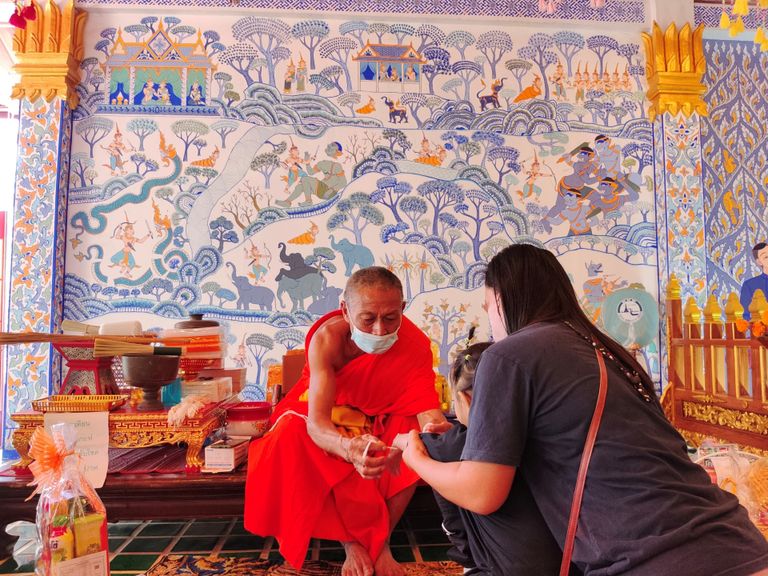
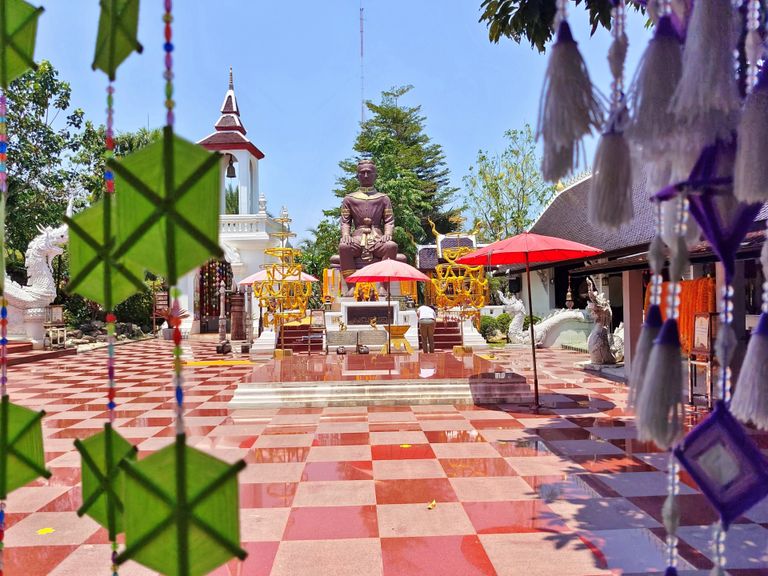

This is a statue of Chao Pho Phraya Lae, the revered first governor of Chaiyaphum Province. Deeply respected by the people of Chaiyaphum, he is remembered not only for his leadership but also for his bravery and dedication to protecting the region. According to local history, Phraya Lae played a significant role in defending Chaiyaphum against invasions, earning him a place of honor in the hearts of the people. His statue serves as a symbol of pride, loyalty, and gratitude, and many visitors come to pay their respects, offering flowers and incense to seek blessings and honor his legacy.
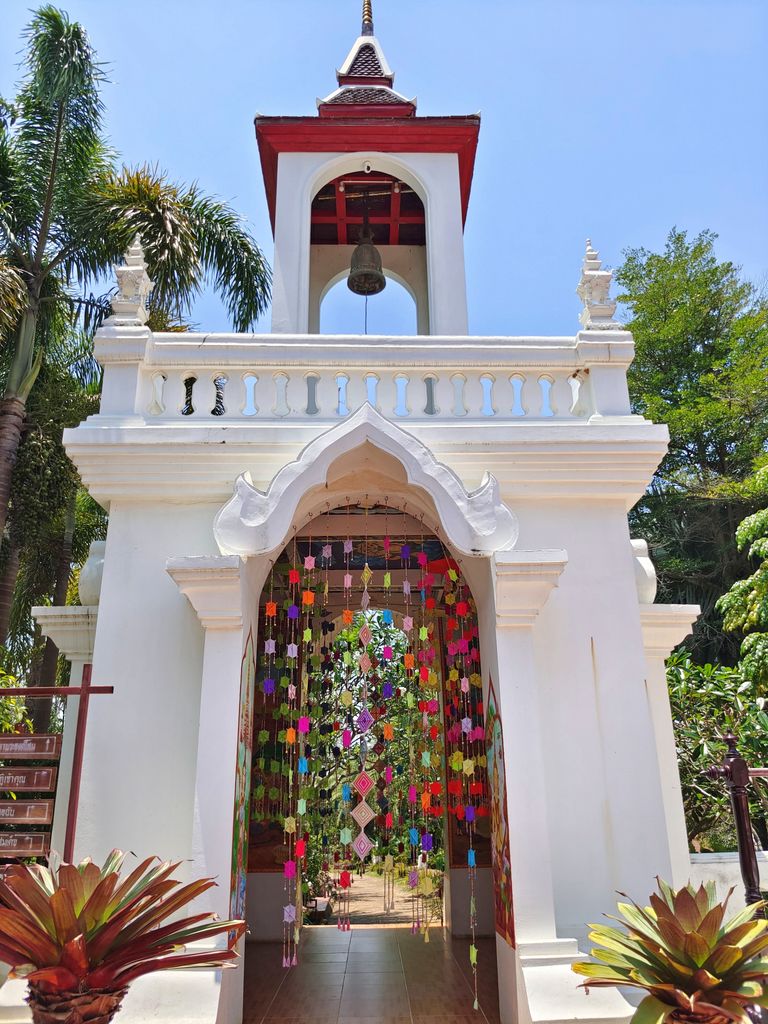
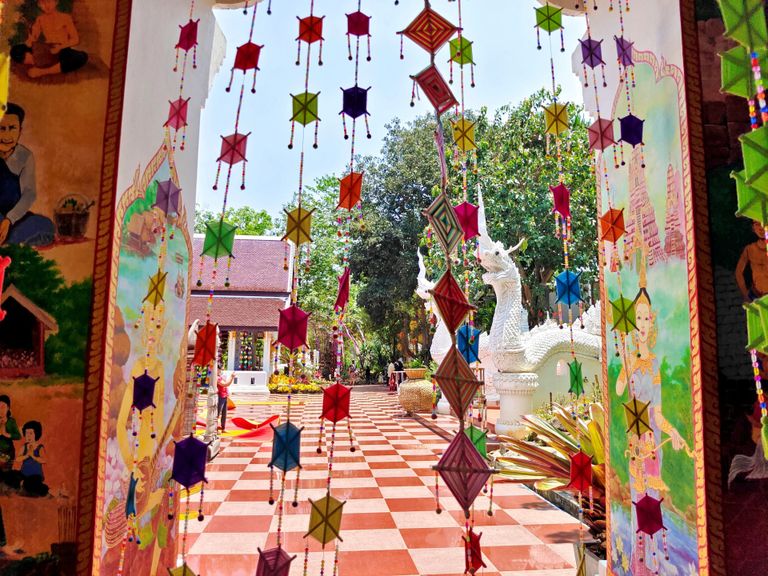
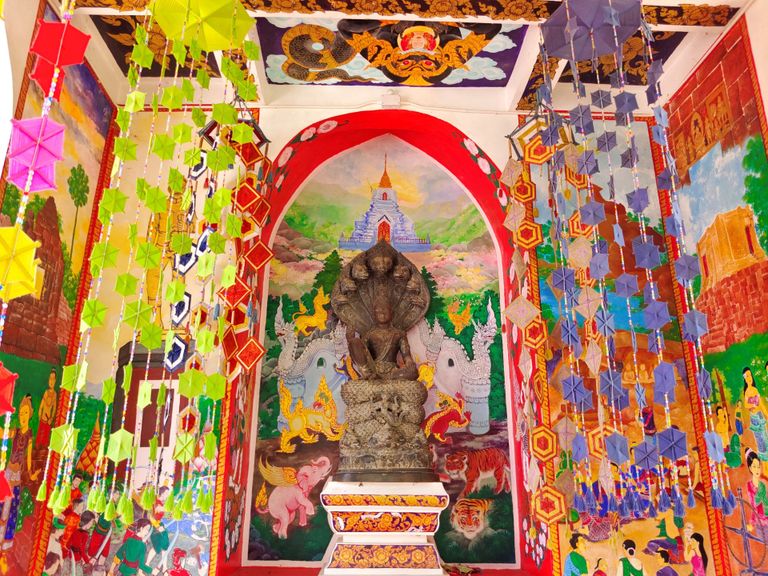
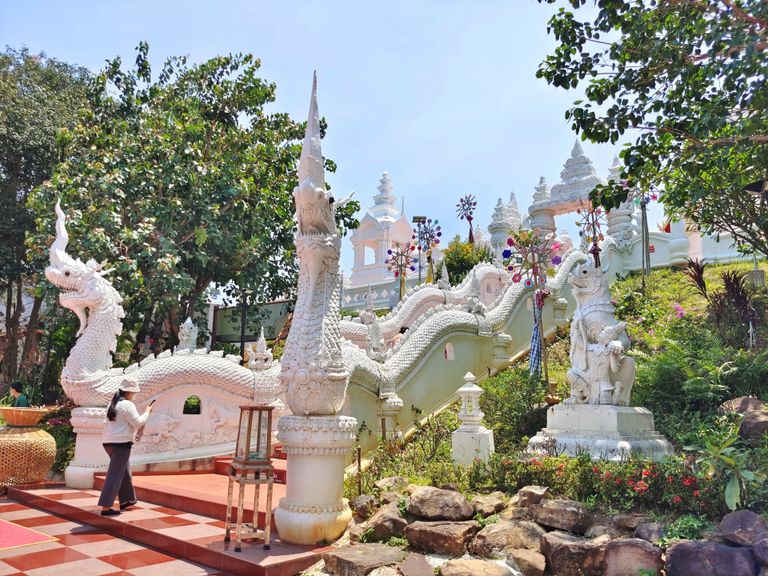
The strikingly white Naga staircase, adorned with intricate stucco patterns, leads visitors on a sacred journey to pay homage to the Buddha's relics. In Buddhist tradition, the Naga is a mythical serpent-like being believed to be a guardian of treasures, sacred sites, and spiritual wisdom. Often depicted with multiple heads, the Naga symbolizes protection and prosperity.
The presence of the Naga along the staircase signifies a safe passage toward enlightenment, guiding visitors toward higher spiritual awareness. The craftsmanship of the stucco patterns showcases the dedication and artistry of local artisans, adding both cultural and spiritual significance to the ascent.
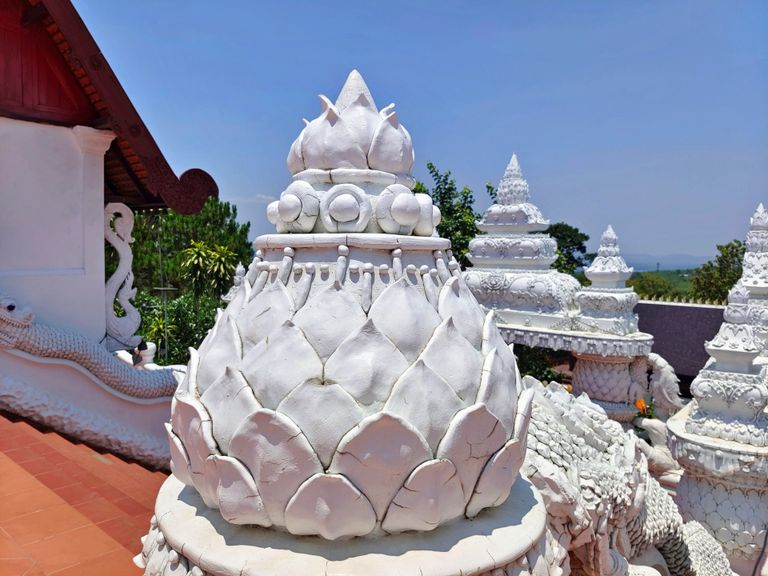
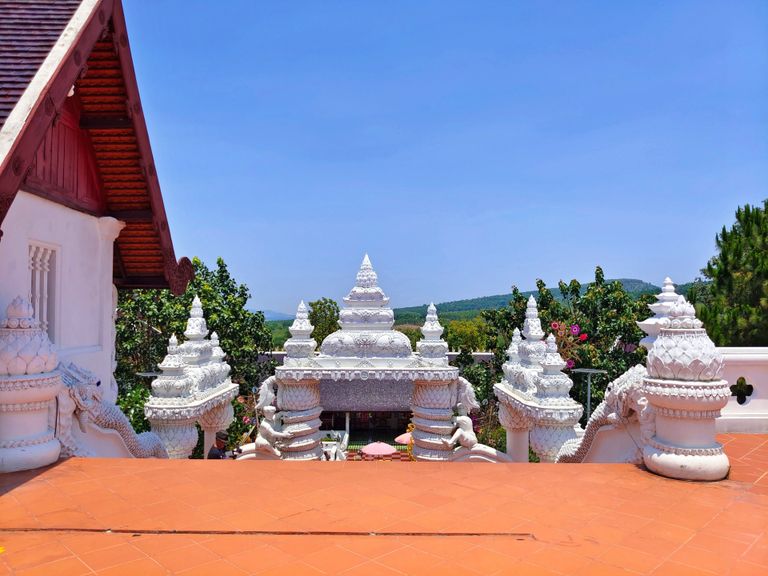
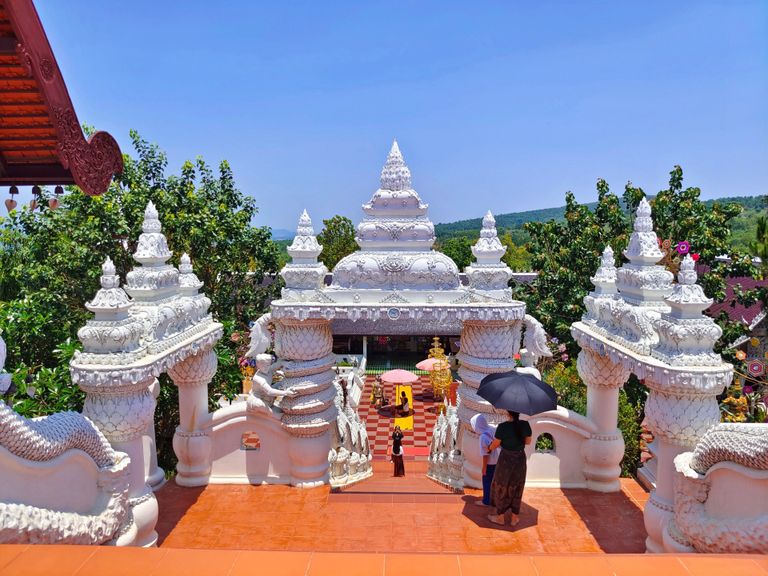
บันไดนาคสีขาวสวยงามสะดุดตาเป็นทางขึ้นไปเคารพสักการะพระบรมสารีริกธาตุ
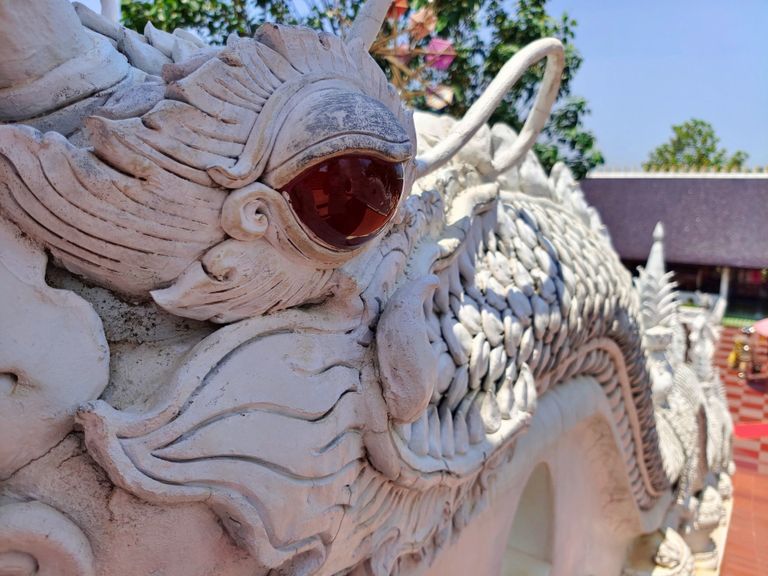
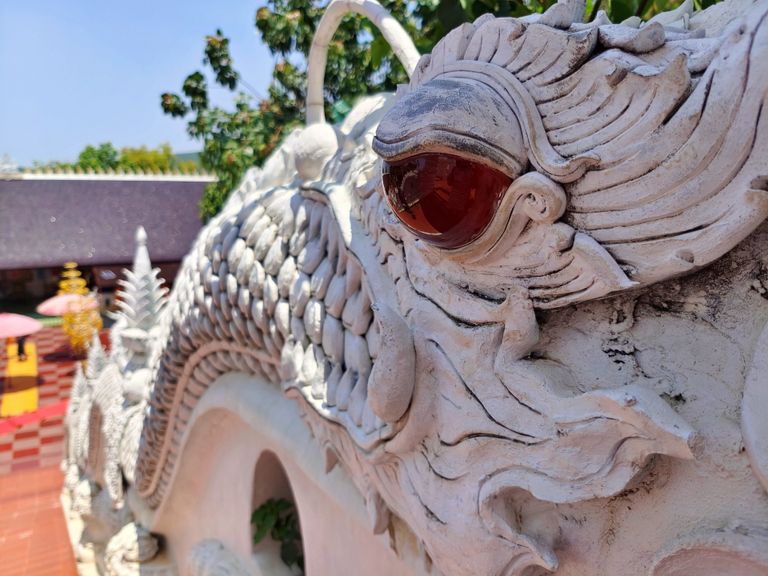
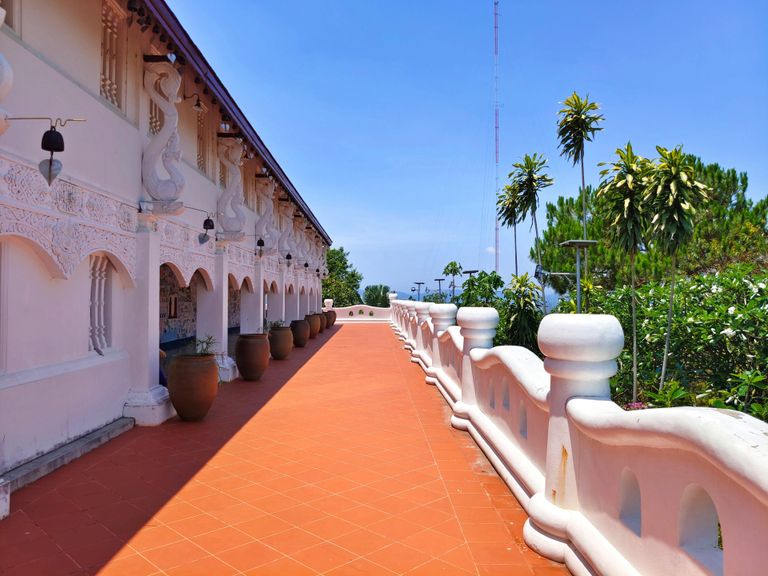
ระเบียงชั้นสองมีภาพจิตกรรมฝาผนังแต่ยังไม่เสร็จสมบูรณ์ บริเวณสามารถมองเห็นวิวสวยๆ ด้านล่างได้ด้วย
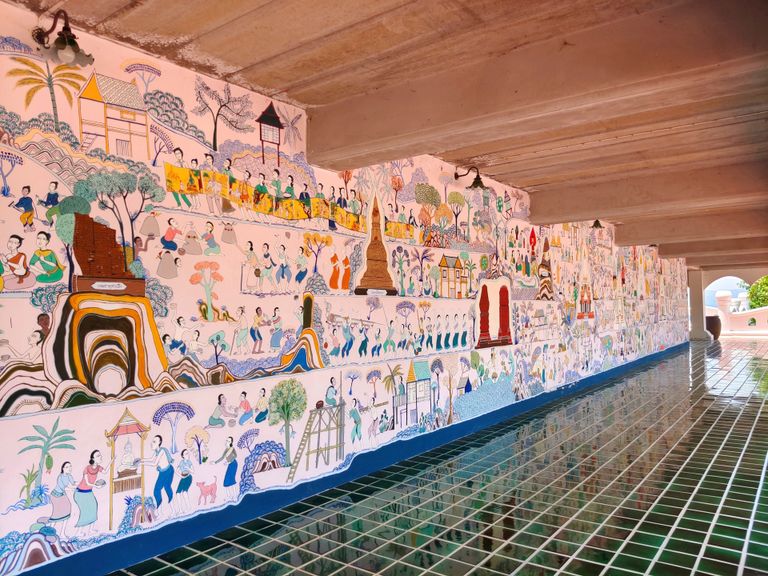
The second-floor balcony features murals, though they are still a work in progress. From this vantage point, visitors can enjoy stunning views of the scenery below.
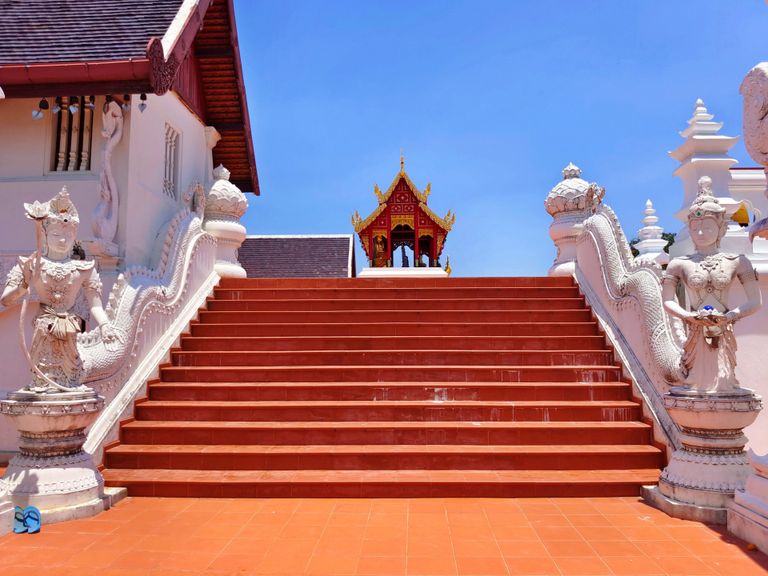
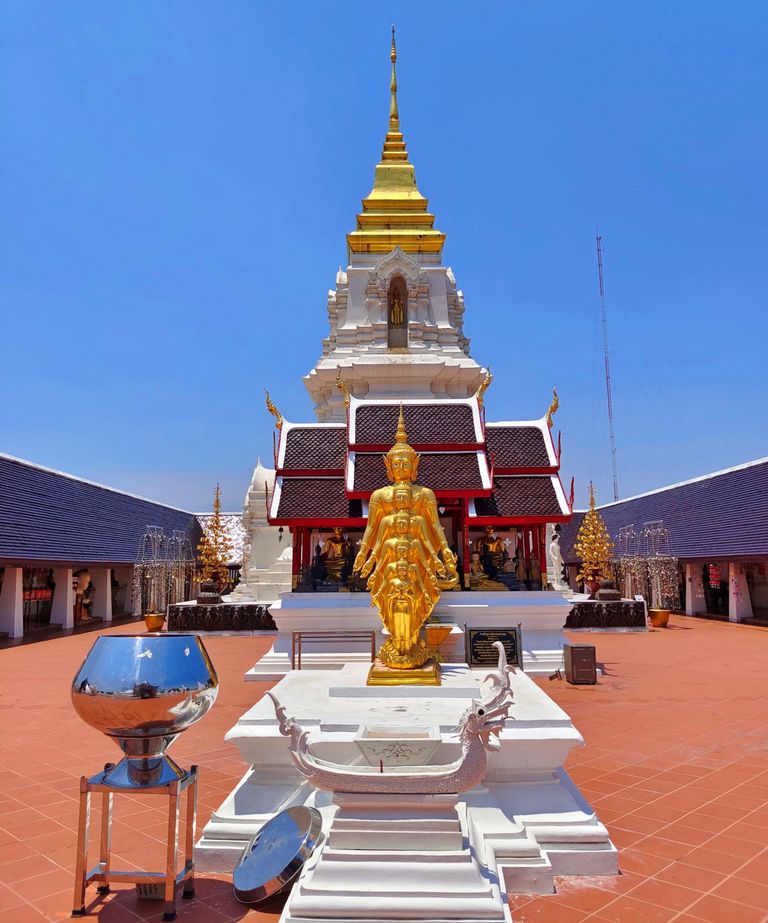
On the top floor is an open courtyard. At its center, five golden Buddha images are stacked in ascending order, from smallest to largest, symbolizing the gradual path of spiritual growth toward enlightenment. Each Buddha represents a stage of progress, reflecting the journey from earthly concerns to spiritual awakening and ultimate liberation.
Behind the statues stands a magnificent white chedi with a golden top. A chedi, also known as a stupa, is a dome-shaped structure that plays a significant role in Buddhist tradition. It is often built to house sacred relics—such as ashes, bones, or other items associated with the Buddha or revered monks—and serves as a focal point for meditation and prayer. The chedi's architectural design symbolizes the path to enlightenment, with the dome representing the world, the spire pointing toward the heavens, and the base connecting the earthly realm to the divine. Pilgrims walk around these stupas as a gesture of devotion, honoring the teachings of the Buddha and cultivating mindfulness..
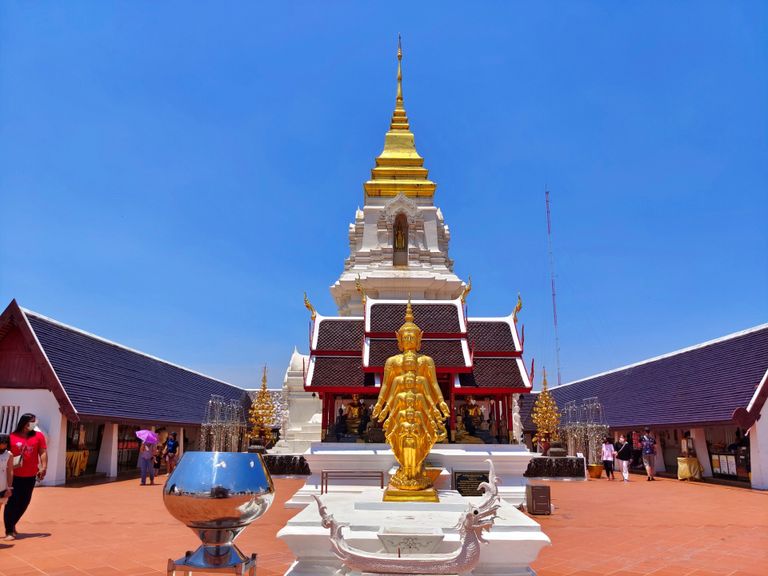
ชั้นบนสุดเป็นลานกว้าง บริเวณตรงกลางมีพระพุทธรูปองค์สีทอง จำนวน 5 องค์ ยืนซ้อนกันเรียงลำดับจากเล็กไปใหญ่ และมีพระธาตุเจดีย์สีขาวยอดเป็นสีทองอยู่ด้านหลัง
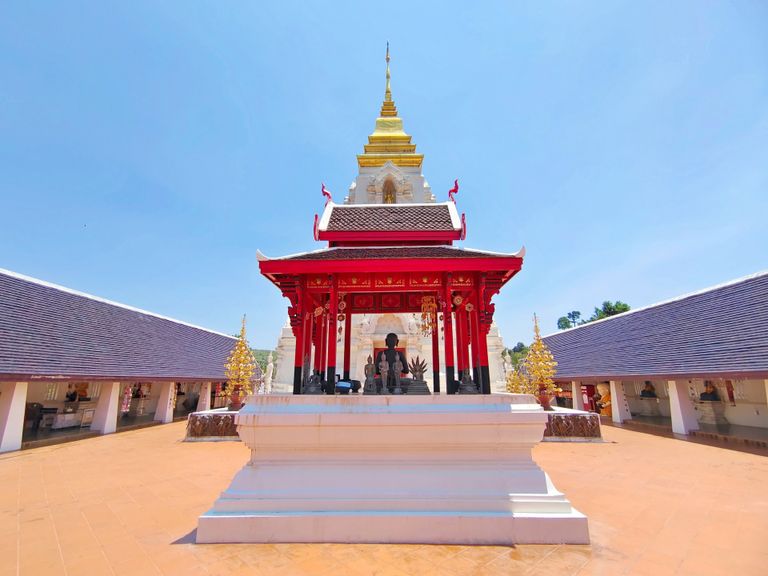
Although the top floor was windy, the hot weather made the tiled floor extremely hot. I wasn’t wearing socks that day, and as I walked, the heat nearly made me jump—hahaha!
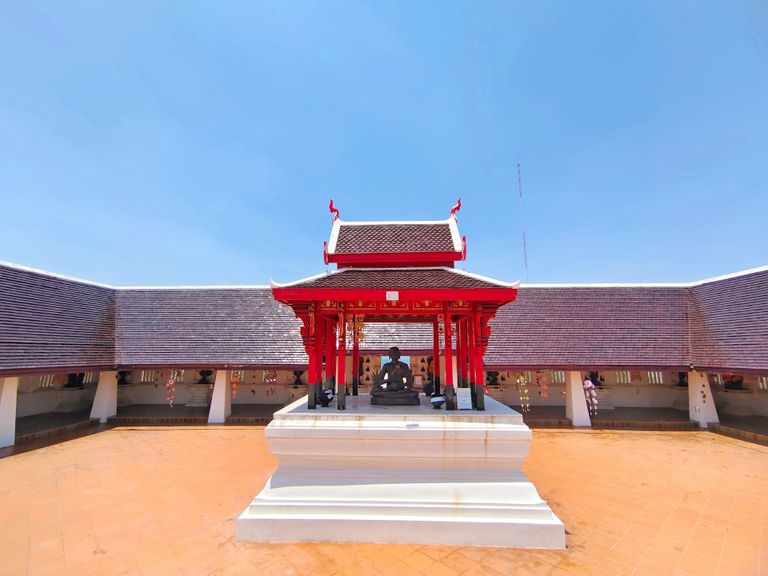
แม้ว่าชั้นบนสุดลมแรง แต่เพราะอากาศร้อนทำให้พื้นที่เป็นกระเบื้องร้อนมากๆ บัวไม่ได้สวมถุงเท้าแทบจะเยียบพื้นไม่ได้เลย เหยียบลงไปแทบจะสะดุ้งเพราะความร้อน 555
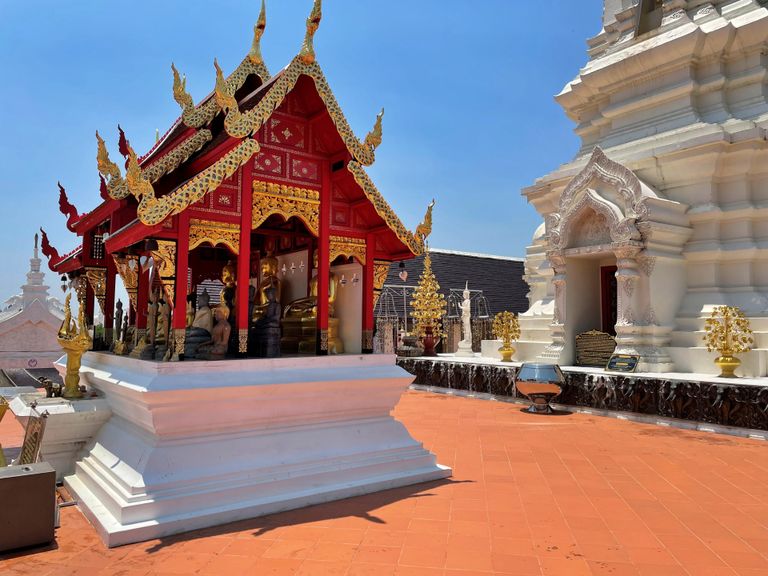
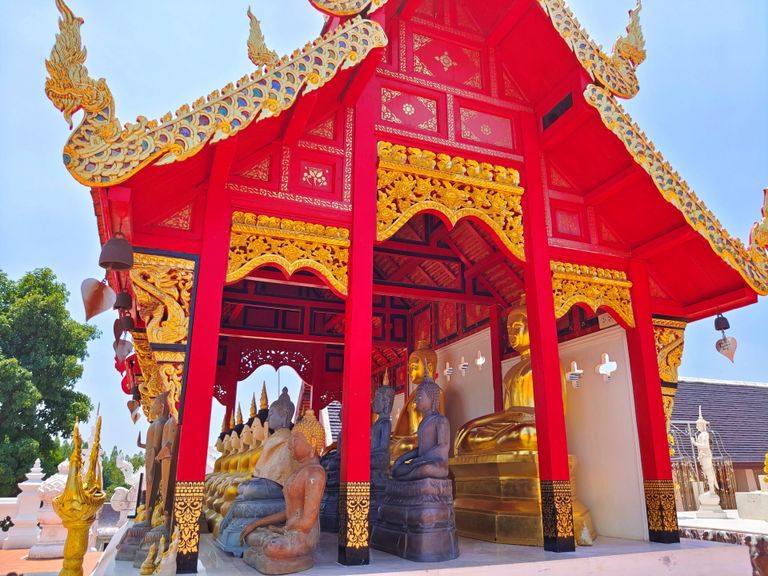
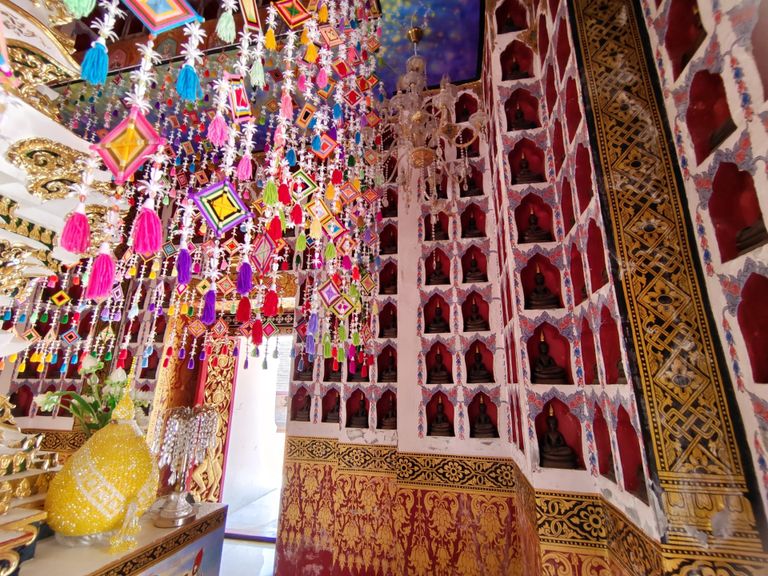
ที่ประดิษฐานพระบรมสารีริกธาตุ
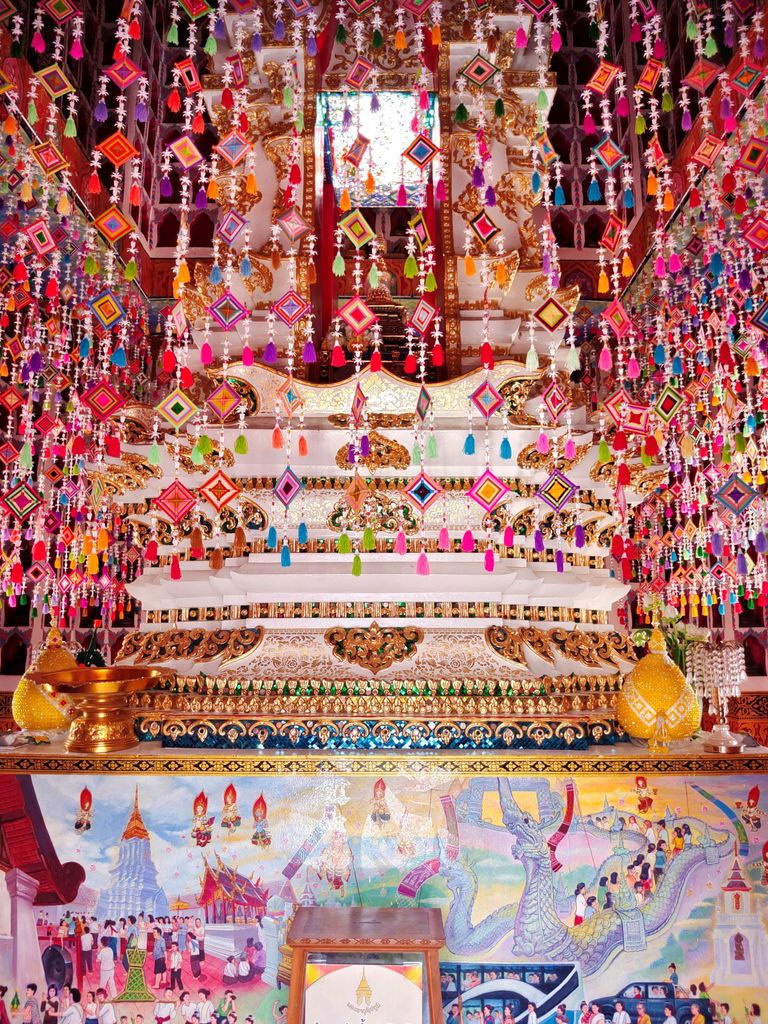
place where the relics of the Buddha are kept.

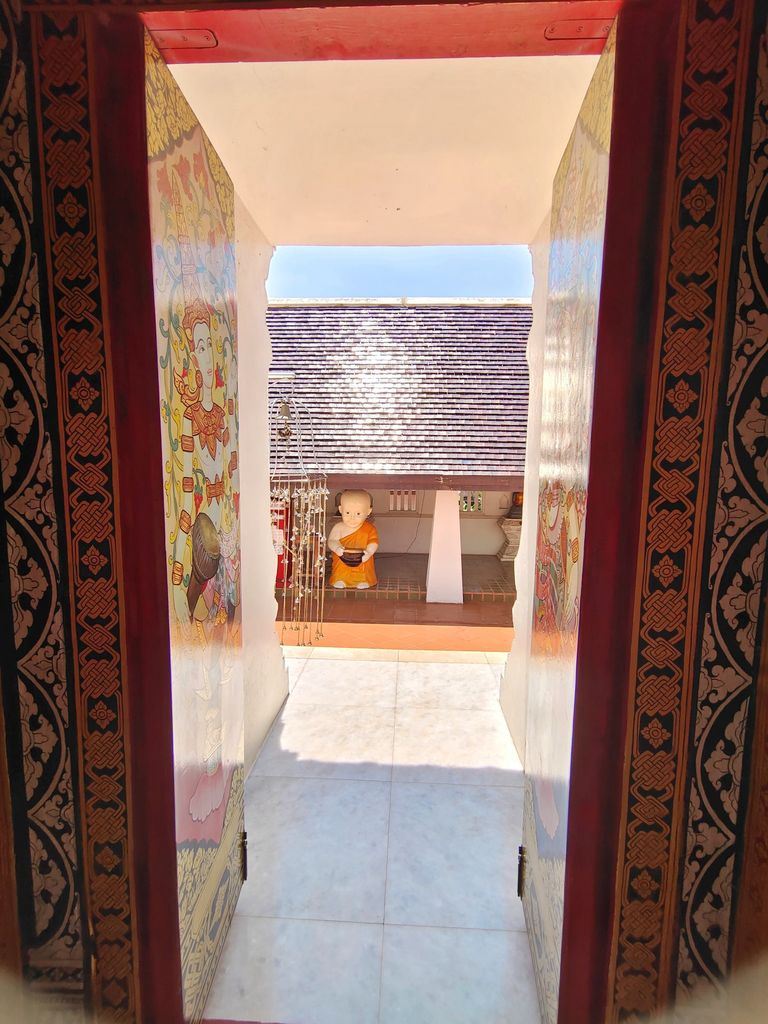
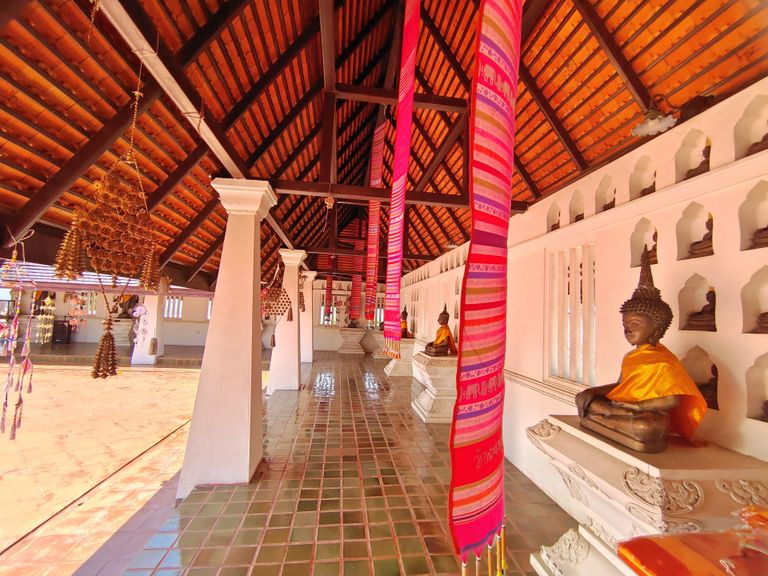
Around the pagoda, a vihara encircles the chedi on three sides, housing numerous Buddha images. A vihara is a hall or sanctuary within a Buddhist temple complex, traditionally used as a gathering place for monks and devotees to study, chant, meditate, and offer prayers. Unlike the main ordination hall (ubosot), which is reserved for special ceremonies, the vihara serves as a more accessible space for regular worship and teachings. The presence of Buddha images enshrined within the vihara invites visitors to reflect, make offerings, and engage in merit-making practices, fostering a deeper connection with the Buddhist teachings.
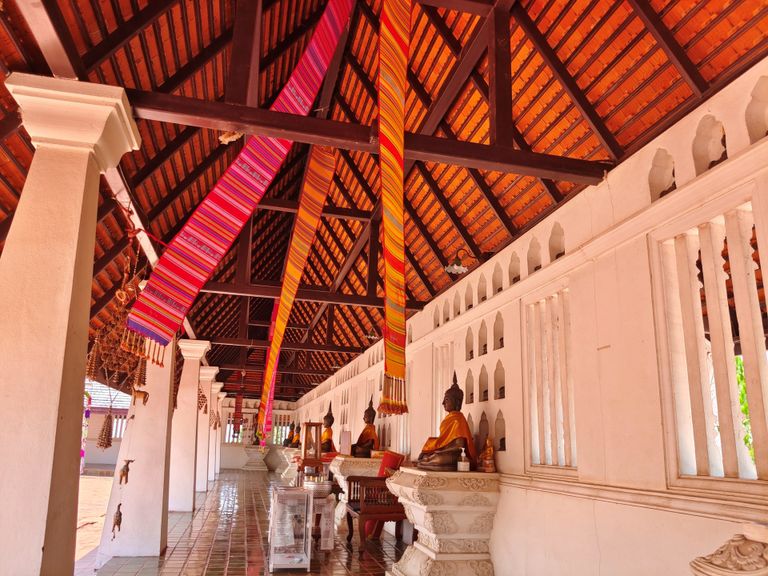
บริเวณรอบพระเจดีย์นั้นมีวิหารรายล้อมรอบองค์พระเจดีย์ 3 ด้าน และประดิษฐานพระพุทธรูปจำนวนมากมาย

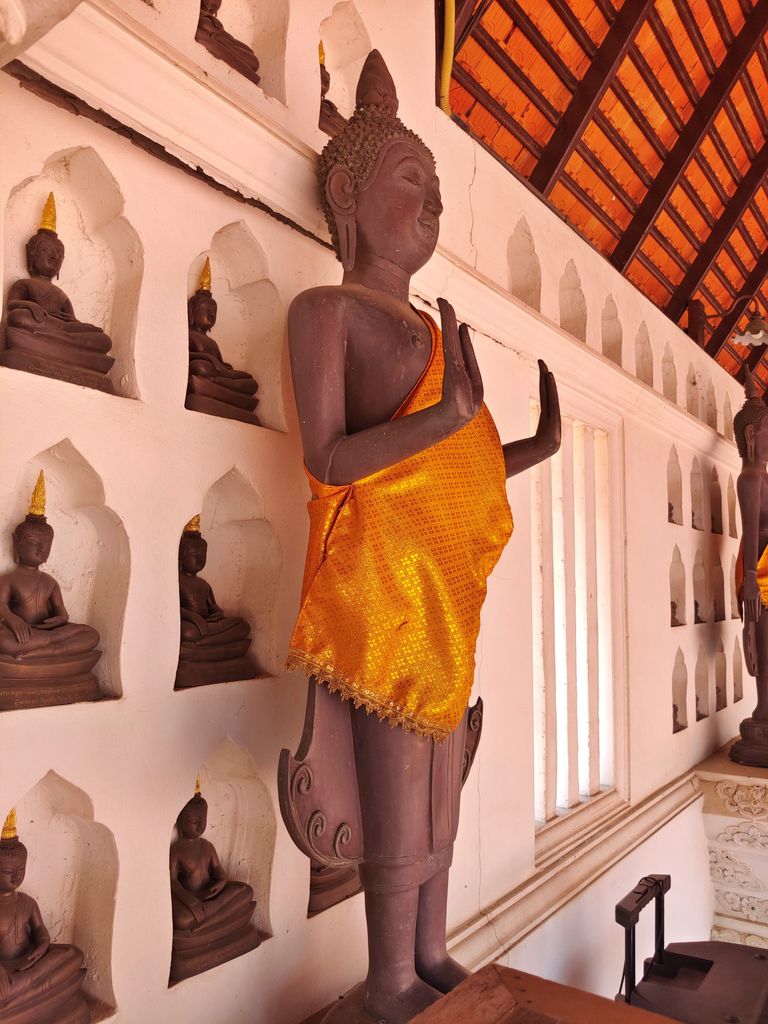
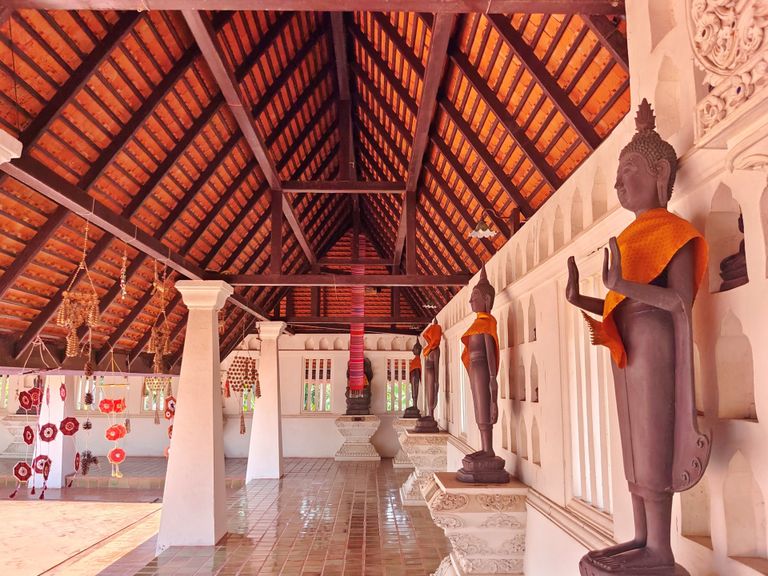
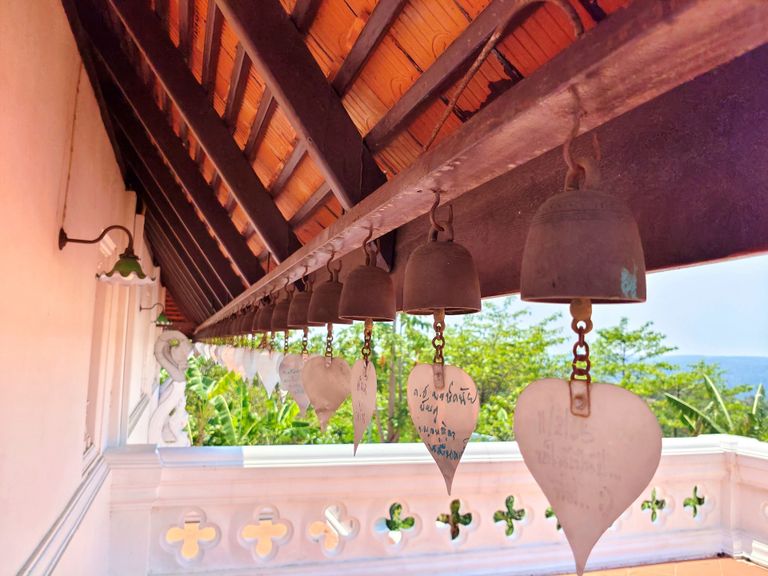
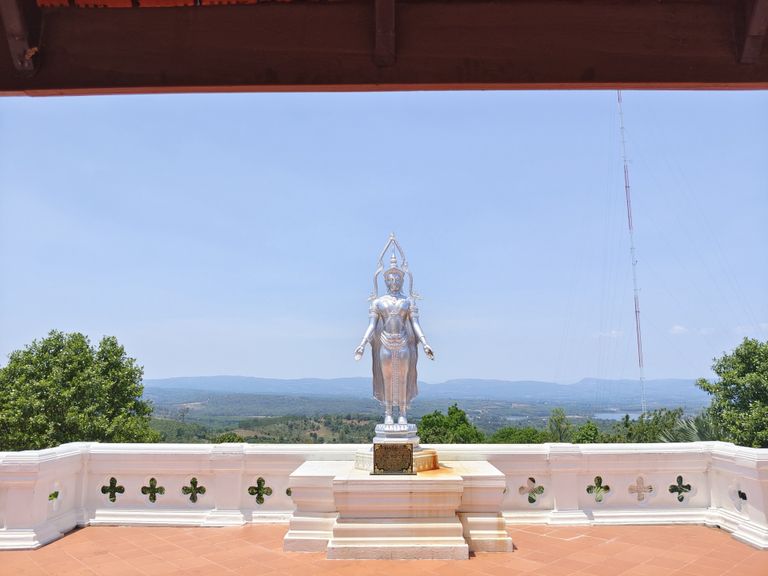
This area features a walkway leading to an outer terrace, where a white Buddha statue stands at the center. This terrace offers a stunning viewpoint, providing panoramic views of Lam Pra Thao Dam and the surrounding greenery.
In Buddhist symbolism, a white Buddha often represents purity, wisdom, and enlightenment. The color white is associated with the absence of impurities and the achievement of spiritual liberation, symbolizing the Buddha’s ultimate state of enlightenment and freedom from worldly desires. The serene expression on the white Buddha serves as a reminder for practitioners to cultivate inner peace, mindfulness, and compassion on their spiritual journey.
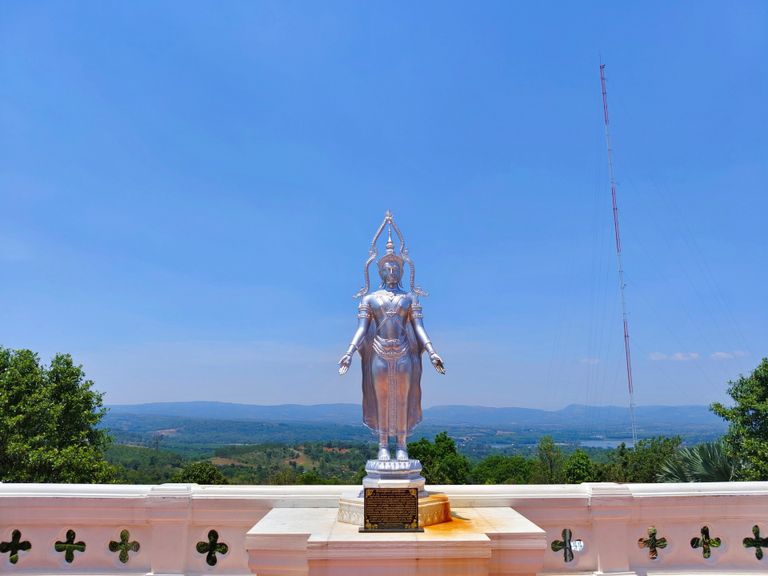
บริเวณนี้มีทางเดินออกไปสู่ระเบียงด้านนอกซึ่งมีพระพุทธรูปสีขาวอยู่ตรงกลาง เป็นจุดชมวิวที่สวยมากๆ จากบริเวณนี้สามารถมองเห็นเขื่อนลำประทาว และความเขียวขจีของต้นไม้
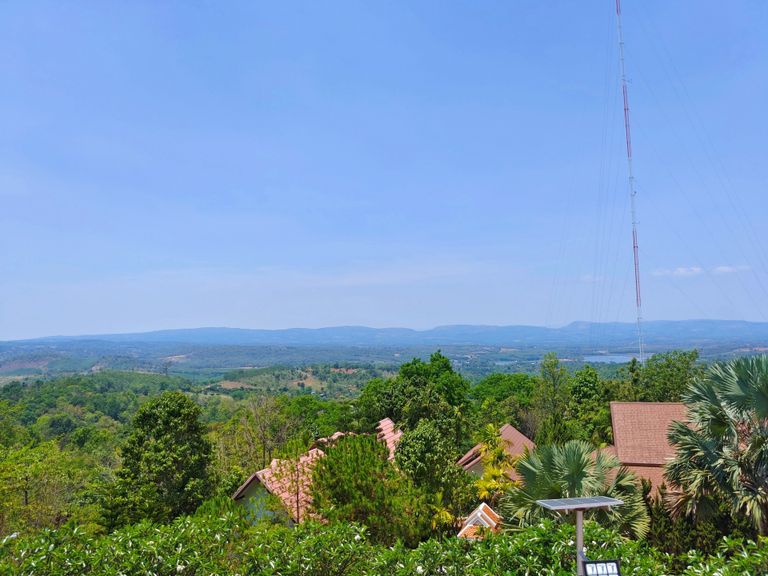
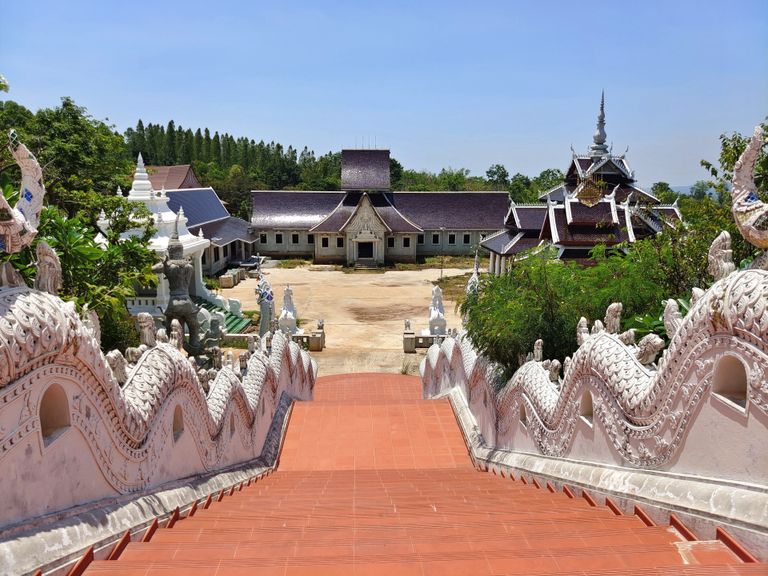
The serpent staircase on the other side is still under construction and has yet to be completed. I think it will take another year or two to finish. My husband and I plan to return in two years to see it completed.

I hope you enjoyed this amazing place and invite you to #travel with Blurt. 😉

| 📷 Picture | smartphone |
|---|---|
| Model | Vivo X60 5G (ART) |
| Type | Android |
| Photographer | @baiboua |
| Location | Phra Chaiyaphum Siri Maha Chedi, Thailand |

Thank you for your support
ขอบคุณสำหรับการโหวต
เลิฟนะยู้ววววววว
